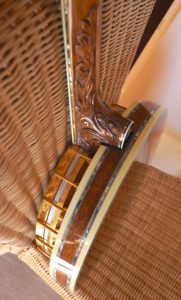Kay or Harmony Tenor Banjo (1961-1963)
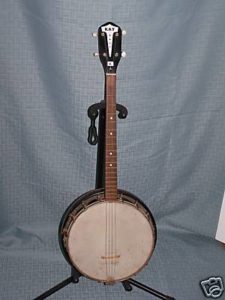
This, my first banjo, was a really inexpensive, difficult to play and terrible sounding instrument. Tuned to standard tenor banjo tuning (C-G-D-A) combined with the high “action” made the first and second strings so taught that they were like pressing down on razor blades.
Having been a Christmas gift and my being a complete novice, it was wonderful despite its shortcomings of which I had no inkling at the time anyway! Thankfully, I have no pictures of that banjo or me playing it. However it was similar to the one shown here on the right.
Vega Professional Plectrum Banjo (1963-1965)
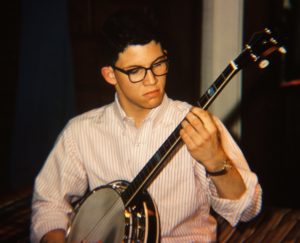
This was my first really good-quality banjo. After about a year struggling with the Kay tenor, my father realized that I was pretty serious about playing and could use a better instrument. After I learned difference between my poor quality tenor and the nice plectrum banjo (B&D Silver Bell #1) that was owned by the camper who had initially inspired me, he agreed to split the $273 cost (I remember the amount!) of a new banjo ordered directly from Vega through our local music store, “The Bandstand.” The difference in playability was amazing to say the least. This is the one I played “Linger Awhile” on Ted Mack’s Original Amateur Hour, I think in 1963.
Vega Vox IV Plectrum Banjo (1965-1980)
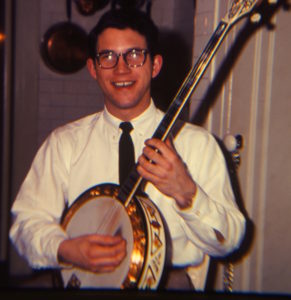
Most banjo players I know like glitzy instruments. After getting pretty good at playing and earning some money teaching at the music store we ordered the Vega Professional from, I decided to step up a couple of notches on the Vega ladder and splurge on a Vox IV—each one custom built with gold plated hardware and uniquely colored designs engraved and painted on the creamy-white resonator. It seemed to me to be the prettiest instrument ever made. I am pretty sure the catalog price was $660 and it took four months for the banjo to be built, shipped and arrive.
I really beat the hell out of this banjo for close to five years but I seem to have no recordings of me playing it that I can track down.
In addition to accompanying me on my first real professional jobs, his banjo taught me that, like drinking and driving, drinking and playing is extremely stupid and dangerous. One winter evening, after playing a fraternity gig at Dartmouth and drinking too many bourbon and gingers, I “forgot” to latch the banjo case shut and while walking back to my dorm room the case flew open and the banjo crashed onto the icy sidewalk, causing a long crack in side of the resonator. I still, to this day almost 50 years later, rarely drink more than a single beer while on a gig. Besides the “danger” involved, too many beers make me lethargic and sleepy—very problematic especially when I’m also playing bass pedals, banjo and singing at the same time!
Baldwin Style D Plectrum Banjo (1971-1980)
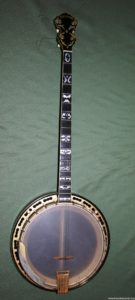
In 1968 I took my Vega Vox IV on a New Jersey-to-Alaska and back trip in a VW Fastback with a Dartmouth classmate to collect butterflies (I was particularly interested in northern and arctic species). When we finally got to Fairbanks, we were pretty dirty and reeked of wood-smoke after three weeks of camping along the Trans-Canada and Alaska Highways, the latter of which was still gravel in the Canadian section. One night we were in one of the local Fairbanks eateries and I heard the sound of a banjo from down the street, so my friend Mark and I investigated and discovered Gary Ryan, a really great plectrum player, performing in a trio. I introduced myself—me in my filthy plaid camping shirt and jeans and him in his tuxedo! He graciously allowed me to sit in for a couple of tunes (I had my Vox IV in hand) and I immediately noticed his banjo, a Baldwin Style F, one of only two of that model ever made (Ed Turner had a tenor). I was impressed by how crisp and clean it sounded as well as how heavy it was!
For three years after meeting Gary in Fairbanks I was on the lookout for a Baldwin plectrum, especially a gold-plated one. I discovered Baldwin Style Cs were nickel-silver and Baldwin Style Ds were gold plated but were otherwise almost identical models. Now, having graduated and back in New Jersey, I combed music stores but could not find a Baldwin anything. Finally, in 1971 I heard of a store north of Philadelphia, “Zapf’s,” that supposedly had a rogue buyer who had stocked up on high-end banjos for some reason, and had a Baldwin D plectrum on display. I jumped at the chance to get it.
(Here is a informative history of Ode, Baldwin, Baldwin-Ode, and Ome banjos.)
I played my Baldwin Style D for the first six years after moving to San Francisco including a couple of years at the Hungry Tiger and the first four of my eight year stint performing intermissions for the Turk Murphy Jazz Band at a number of Earthquake McGoon’s locations in San Francisco. Here is a sample of what it sounded like. My setup at McGoon’s included bass pedals that I played (and still play) with my right foot and an electronic “rhythm box” controlled with a foot switch (left foot).
“Alabama Jubilee” Scott Anthony at Earthquake McGoon’s, October 1980
Because Earthquake McGoon’s was especially set up for dancing, I used to do a lot of medleys of tunes with similar tempos, usually made up on the spot. I’d be playing a tune and another one would pop into my head, usually in a different key to keep things interesting for the dancers. Here is one of them—same time, same banjo:
Medley: “Who’s Sorry Now” and “Somebody Else Is Taking My Place” Scott Anthony at Earthquake McGoon’s, October 1980
Ome Gold Mogul (1980-1982)
Sometime around 1980, John Gill purchased a custom Ome Big Mogul directly from Ome at a great price as a one-year promotional for the company. The Turk Murphy band was traveling quite a bit then and playing an Ome in the band was good advertising for them. After trying his Big Mogul I decided that it felt and sounded exactly the way I wanted a banjo to be and wanted one like it. The great banjo dealer in San Francisco, Russ Presting, had an Ome Gold Mogul, a model almost identical to but less ornate than the Big Mogul for sale and I traded my Vega Vox IV for it. I had never been able to get my Vox IV to sound as good as my Baldwin D or as it turns out, any of the Omes I have tried, so the loss of the trusty old Vox IV was not as difficult as one might imagine. I would, however, be interested to know where my Vox IV wound up just out of curiosity.
Ome Big Mogul (Ome calls it a “Juggernaut”) (1982-present)
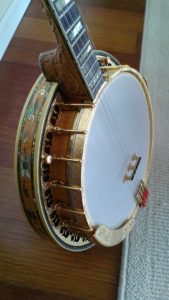
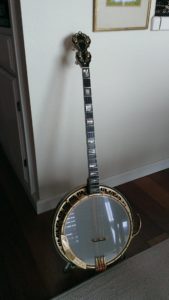
At the end of the promotional year, John Gill decided he was not particularly happy with the banjo he had purchased from Ome, and gave me the first offer chance to buy it from him. His selling price was such that I could not turn it down, and I still own it. It is a great banjo, with a very Ome’y sound and feel.
In the mid-1990s I commis-sioned Renee’ Karnes to inlay a floral design on the side of the resonator. As you can see, the inlay is beautifully done, as is typical for her work. Inlaying pearl on light colored maple is particularly difficult, and this example is exceptionally clean.
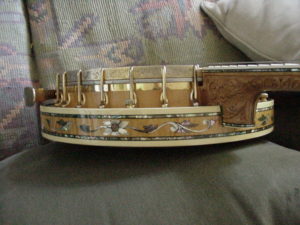
Living in San Francisco, and now right next to the Pacific Ocean in Pacifica, for a total of almost 30 years, the salty air had caused the engraved bronze metal parts to show green corrosion seeping through the gold plating on this great instrument, so in 2013 on our trip to play the Evergreen Jazz Festival I took the opportunity to leave the banjo with Ome at their workshop in Boulder to be re-plated. They did a great job!
B&D Montana Special (1994-present)
Any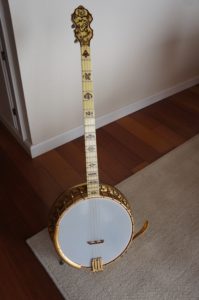 one who has heard the late great Buck Kelly perform knows that he was one of the finest plectrum banjo players ever, as well as a wonderful ragtime piano player. I first met Buck at a rather dismally attended jazz festival in Roundup, Arizona in the mid 1980s where my original Golden Gate Rhythm Machine (Bob Neighbor on cornet, Jack Frost on guitar, and me on banjo, pedal bass and rhythm box) were appearing. We became pretty good long-distance friends, and saw each other at a number of Helena Jazz Festivals and other places for a few years.
one who has heard the late great Buck Kelly perform knows that he was one of the finest plectrum banjo players ever, as well as a wonderful ragtime piano player. I first met Buck at a rather dismally attended jazz festival in Roundup, Arizona in the mid 1980s where my original Golden Gate Rhythm Machine (Bob Neighbor on cornet, Jack Frost on guitar, and me on banjo, pedal bass and rhythm box) were appearing. We became pretty good long-distance friends, and saw each other at a number of Helena Jazz Festivals and other places for a few years.
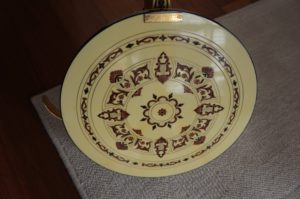 In late 1990 my family and I were visiting my mother, sister and brother-in-law in Maryland and I arranged with Buck to come over the the Fish Market in Alexandria, VA to sit in with him for the evening. Since I had not brought a banjo with me, Buck’s wife brought this banjo for me to play. This evening turned out to be the last time I ever saw him. I bought this banjo, the one Debbie brought for me to play, a few years later.
In late 1990 my family and I were visiting my mother, sister and brother-in-law in Maryland and I arranged with Buck to come over the the Fish Market in Alexandria, VA to sit in with him for the evening. Since I had not brought a banjo with me, Buck’s wife brought this banjo for me to play. This evening turned out to be the last time I ever saw him. I bought this banjo, the one Debbie brought for me to play, a few years later.
B&D Silver Bell #8 Ne Plus Ultra (possible clone)
Every year there is a guitar show in mid-January at the Marin County Civic Center. I was wandering around the exhibit floor at the 2006 show and saw a beautiful B&D for sale by one of the vendors. I asked to try it out and it was great—it sounded great and had a wonderful low action with no buzz whatsoever. I was very impressed, but the price was way beyond what I could afford at the time.
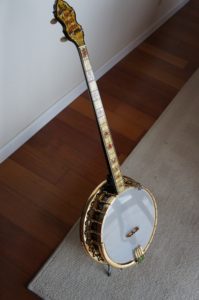
The next year at the same show—2007 version—I saw the same vendor with the same banjo on a stand for sale, but with the price cut virtually in half. I had fortunately brought one of my custom archtop plectrum guitars that I had built “on spec” to the show to see if anyone was interested in purchasing it and the banjo vendor was impressed with it but did not want a 4-string guitar. We made a deal that I would build him a custom 6-string archtop in exchange for the banjo, shown here.
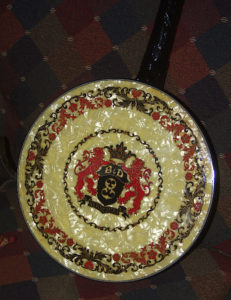
I have no particular concern about it, but there is some mystery revolving around this banjo, namely that it is a clone and not a real Bacon and Day (or Gretsch) instrument. The serial number on the dowel stick has been altered and there are quite a few departures from customary B&D inlay and decorative designs plus other discrepancies that point to a non-original. I have never been a collector of banjos but rather I own them to play them, and this banjo, whatever its provenance, is great not only because of its esthetic qualities but also its playability and sound.
More images of the B&D Silver Bell #8 Ne Plus Ultra
Ome Columbine (2013 to present)
 On our drivee home from a jazz festival trip to the Evergreen Jazz Festival and the Bix Festival in Davenport, Iowa in August of 2013, I dropped off both my Ome Big Mogul and the above B&D Silver Bell #8 Ne Plus Ultra at the Ome workshop to be re-plated. While hanging around the showroom waiting for a repair on the Big Mogul I was playing a few of the display plectrum banjos. One, in particular, was both beautiful and sounded great. After a few minutes, my wife said, “I think you need to have that banjo!” Well, alrighty then! It is now my main playing instrument.
On our drivee home from a jazz festival trip to the Evergreen Jazz Festival and the Bix Festival in Davenport, Iowa in August of 2013, I dropped off both my Ome Big Mogul and the above B&D Silver Bell #8 Ne Plus Ultra at the Ome workshop to be re-plated. While hanging around the showroom waiting for a repair on the Big Mogul I was playing a few of the display plectrum banjos. One, in particular, was both beautiful and sounded great. After a few minutes, my wife said, “I think you need to have that banjo!” Well, alrighty then! It is now my main playing instrument.
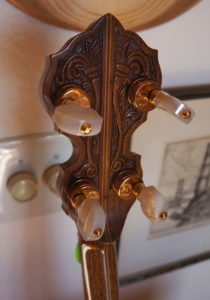 Unlike most of Ome’s banjos that are Maple, this one is all Walnut with beautiful abalone inlay accenting the binding. The back of the peghead and the heel are carved with a nice floral design. It is a truly wonderful banjo.
Unlike most of Ome’s banjos that are Maple, this one is all Walnut with beautiful abalone inlay accenting the binding. The back of the peghead and the heel are carved with a nice floral design. It is a truly wonderful banjo.
